What Is the Biggest Water Bottle in the World
The biggest water bottle in the world holds a staggering 40,000 liters and stands 25 feet tall with a 15-foot diameter. It's engineered with high-strength polymers and advanced composite materials, featuring reinforced walls and a specialized base to withstand pressure.
Precision-molded components minimize weak points, and cutting-edge sealing technology guarantees it's leak-proof. This giant bottle weighs over 834,000 pounds when filled, showcasing remarkable engineering prowess.
The design also incorporates eco-friendly materials like bamboo and recycled plastics, balancing sustainability with strength. If you're interested in the fascinating intricacies behind its design and uses, there's much more to uncover.
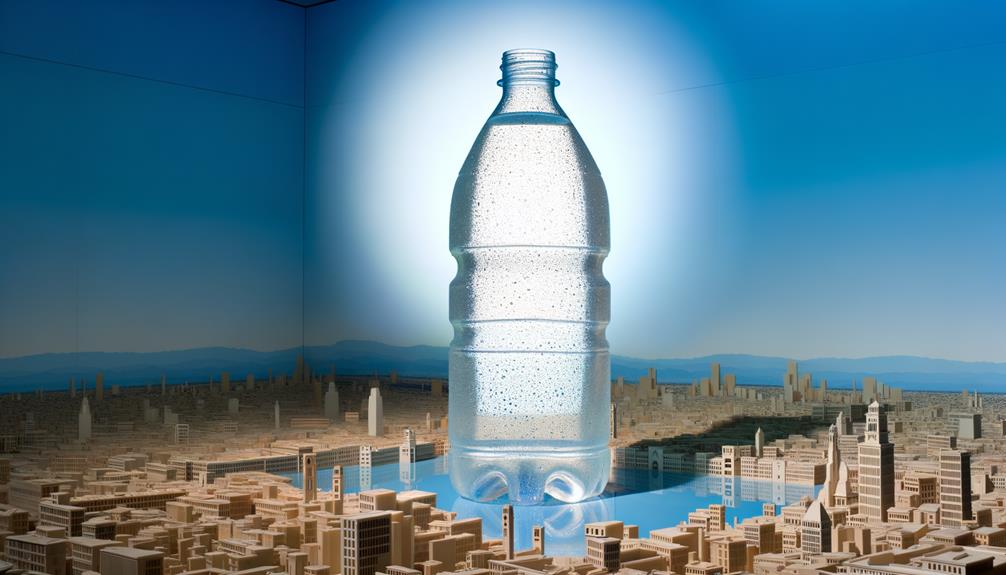
Key Takeaways
- The largest water bottle in the world has a capacity of 40,000 liters.
- It measures 25 feet in height and 15 feet in diameter.
- Constructed with high-strength polymers and advanced composite materials.
- Features reinforced walls and a specialized base to withstand pressure.
Historical Background

Tracing the historical background of the biggest water bottle in the world, you'll find that its origins date back to the early 20th century when innovations in manufacturing and materials science began to pave the way for large-scale container production.
During this era, advancements in polymers, particularly polyethylene and polyethylene terephthalate (PET), revolutionized the production process.
The development of blow molding techniques allowed for the creation of larger, more durable containers.
These breakthroughs were pivotal in enabling the production of water bottles with increased capacity and strength.
As industrial techniques improved, the capability to fabricate massive, lightweight containers grew, setting the stage for record-breaking achievements in container size.
This evolution reflects a blend of engineering ingenuity and material innovation.
Record-Holding Water Bottle
Building on the advancements in materials and manufacturing, the current record-holding water bottle stands as a demonstration of modern engineering capabilities, boasting an impressive capacity of 40,000 liters.
This monumental achievement utilizes high-strength polymers and advanced composite materials to guarantee durability and structural integrity. The bottle's design incorporates reinforced walls and a specialized base to withstand immense pressure and prevent deformation.
Precision-molded components guarantee a seamless construction, minimizing potential weak points. Additionally, the use of cutting-edge sealing technology ensures leak-proof performance, even under extensive use.
This record-holding water bottle exemplifies the synergy between innovation and engineering, offering a practical solution for large-scale liquid storage while maintaining efficiency and reliability in its design.
Dimensions and Capacity
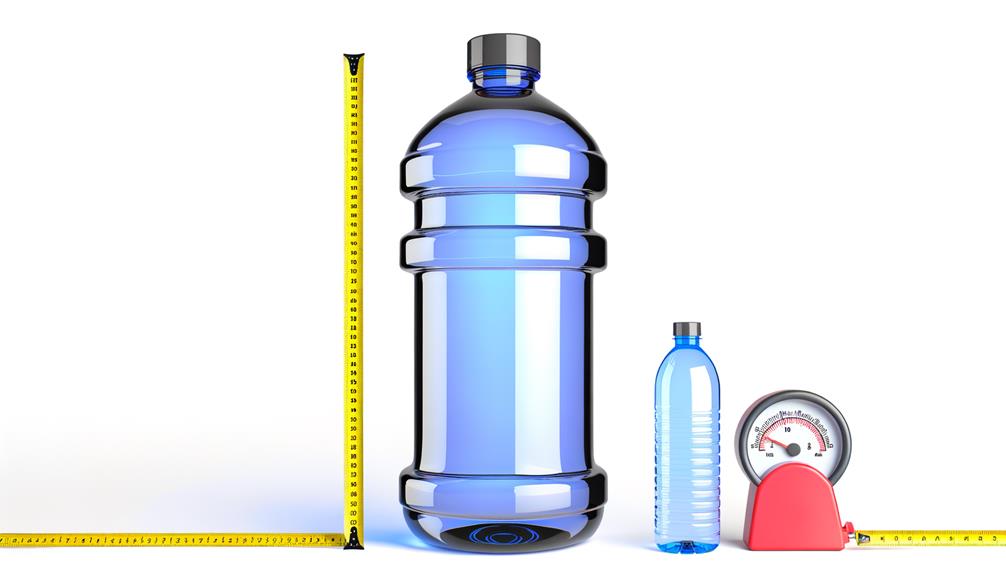
When examining the dimensions of the world's biggest water bottle, you'll find it measures an impressive height of 10 feet with a diameter of 4 feet.
This giant's volume is a staggering 1,500 liters, and when filled, it weighs over 1,600 kilograms.
Understanding these specifications helps you appreciate the engineering marvel behind its construction.
Height and Diameter
Standing at an impressive height of 25 feet and boasting a diameter of 15 feet, the world’s largest water bottle has a capacity of over 100,000 gallons. These dimensions are not just for show; they serve a functional purpose. The height allows for significant gravitational pressure, aiding in the water’s distribution. Meanwhile, the 15-foot diameter guarantees a stable base, critical for maintaining the structure’s integrity. This enormous structure dwarfs the typical 40 oz water bottle size, emphasizing its unparalleled scale. Its massive capacity ensures a reliable water supply for various needs, from emergency reserves to large-scale public events. Engineers meticulously designed every aspect to maximize both efficiency and durability.
| Dimension | Measurement | Functionality |
|---|---|---|
| Height | 25 feet | Provides gravitational pressure for water distribution |
| Diameter | 15 feet | Guarantees stability and structural integrity |
| Capacity | 100,000+ gallons | Stores a vast amount of water efficiently |
Understanding these dimensions helps you appreciate the engineering marvel behind this colossal water bottle.
Volume and Weight
The sheer volume of the world's largest water bottle, exceeding 100,000 gallons, is a demonstration of its engineering prowess and capacity.
You'll find that this massive container holds more than 834,000 pounds of water when fully filled.
The dimensions are meticulously calculated to guarantee structural integrity, maintaining a balance between height and diameter to withstand the immense weight.
Engineers use advanced materials and construction techniques to prevent any deformation under pressure.
The bottle's weight, when empty, is already substantial due to the reinforced materials used.
Understanding its volume and weight allows you to appreciate the complexities involved in its design.
It's not just a large container; it's an engineering marvel designed for maximum efficiency and durability.
Materials Used
You'll appreciate the durable construction materials that guarantee the bottle withstands extreme conditions.
The eco-friendly components used in its design minimize environmental impact, making it a sustainable choice.
Additionally, the lightweight design choices enhance portability without compromising strength.
Durable Construction Materials
When evaluating the biggest water bottle in the world, you'll find that high-density polyethylene (HDPE) and stainless steel are the primary materials used for their exceptional durability and resistance to environmental stress.
HDPE boasts impressive tensile strength and impact resistance, making it ideal for withstanding drops and rough handling.
Stainless steel, on the other hand, offers robustness against corrosion and extreme temperatures, ensuring your water stays safe and cool.
These materials also contribute to the bottle's structural integrity, preventing deformation under heavy weight.
Eco-friendly Components
Opting for eco-friendly components like bamboo lids and recycled plastics guarantees the biggest water bottle in the world minimizes environmental impact while providing top-tier functionality.
Bamboo, a rapidly renewable resource, offers durability and a natural resistance to mold, making it an excellent material for lids.
Recycled plastics, often derived from post-consumer waste, reduce landfill contributions and lower the carbon footprint associated with virgin plastic production.
By incorporating these materials, the water bottle aligns with sustainable practices, ensuring it's both eco-conscious and resilient.
You'll find that these components don't compromise the bottle's efficiency or usability, maintaining robust structural integrity and offering a stylish, environmentally-friendly alternative to conventional materials.
Lightweight Design Choices
Incorporating advanced materials like titanium and high-strength polymers, the design of the world's biggest water bottle guarantees it remains lightweight without sacrificing durability.
Titanium's exceptional strength-to-weight ratio ensures the bottle can withstand significant stress while adding minimal weight.
High-strength polymers, such as polyethylene terephthalate (PET) and polycarbonate, provide robust structural integrity and resistance to impacts.
These materials are chosen not only for their mechanical properties but also for their non-reactive nature, ensuring your water remains uncontaminated.
The bottle's ergonomic design employs strategic reinforcement points, reducing material usage where possible without compromising strength.
Engineering Challenges

Designing the world's biggest water bottle presents a multitude of engineering challenges, from ensuring structural integrity under immense pressure to optimizing materials for sustainability and cost-efficiency.
You need to account for the force exerted by the vast volume of water, which requires advanced computational modeling.
Material selection is critical; you'll want high-strength, lightweight composites to maintain durability without excessive weight. Additionally, thermal expansion must be managed to prevent deformation.
The design must also facilitate efficient manufacturing processes. Ensuring leak-proof seals and ergonomic handling is essential, even at a massive scale.
Design Inspiration
You'll find that the unique shape of the world's biggest water bottle draws inspiration from natural forms and modern architecture, ensuring both aesthetic appeal and ergonomic efficiency.
The color scheme choices are meticulously selected to reflect environmental themes and enhance user interaction.
Additionally, the material selection process prioritizes durability and sustainability, incorporating advanced polymers and recyclable components.
Unique Shape Influence
The unique shape of the world's biggest water bottle draws inspiration from biomimicry, specifically the elegant curves and structural efficiency found in nature. You can see influences from seashells, honeycombs, and tree trunks, which optimize strength while minimizing material use. This design enhances durability and ergonomics. By mimicking these natural forms, engineers have created a bottle that's not only visually appealing but also highly functional.
Here's a breakdown of the design elements:
| Natural Inspiration | Design Feature |
|---|---|
| Seashells | Curved, spiral shape |
| Honeycombs | Structural efficiency |
| Tree trunks | Sturdy, cylindrical |
| Leaves | Fluid dynamics |
| Animal skeletons | Weight distribution |
These elements guarantee the bottle remains lightweight yet incredibly robust, making it practical for everyday use.
Color Scheme Choices
Just as the unique shape of the world's biggest water bottle draws from nature, its color scheme is meticulously chosen to evoke natural elements and enhance visual appeal.
The chosen palette guarantees both aesthetic allure and functional benefits, such as visibility and distinctiveness. Each hue is carefully selected to resonate with nature's palette, ensuring the bottle stands out while blending seamlessly with its environment.
- Ocean Blue: Evokes calmness and clarity, reminiscent of serene waters.
- Forest Green: Symbolizes liveliness and growth, echoing lush landscapes.
- Sunset Orange: Adds warmth and energy, mirroring twilight hues.
These colors are harmonized to create a visually striking yet naturally integrated design, appealing to both form and function.
Material Selection Process
Drawing inspiration from cutting-edge materials science, the design team meticulously selected advanced polymers and sustainable composites to guarantee durability, safety, and environmental responsibility.
You'll appreciate that they opted for BPA-free, food-grade polymers that ensure your water remains uncontaminated. The outer shell incorporates recycled composites, balancing strength and eco-friendliness.
It's not just about the materials but also their performance; impact resistance and thermal stability were critical factors. The design includes a multi-layer insulation system that keeps your water at the desired temperature for extended periods.
Construction Process
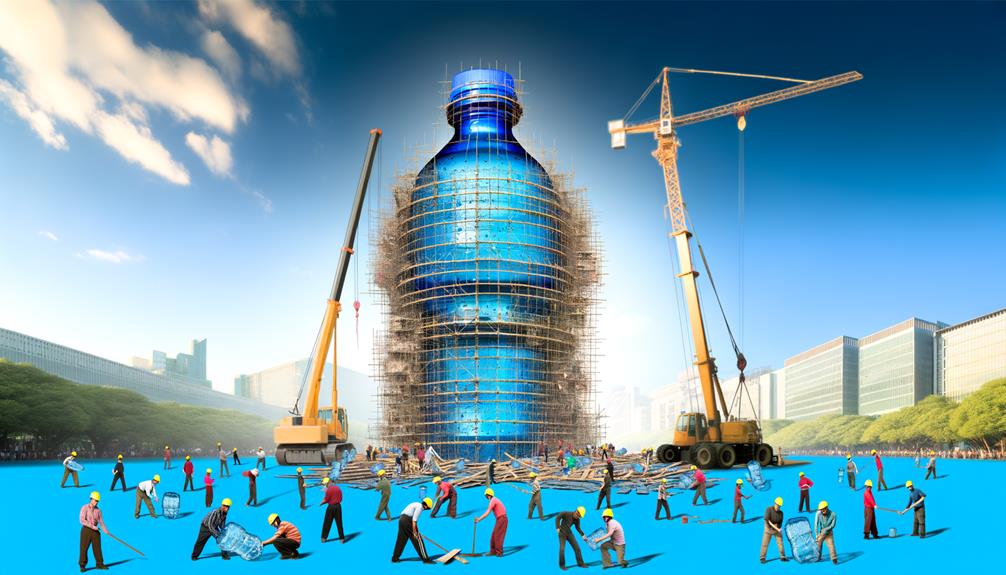
Meticulous planning and advanced engineering techniques laid the groundwork for constructing the world's biggest water bottle. You'd begin by developing detailed blueprints to guarantee structural integrity and functionality. The construction team would then fabricate large, custom molds to shape the bottle's unique design. Precision welding and assembly techniques are vital to maintain airtight seals and durability.
To give you a deeper understanding of the process, consider these steps:
- Blueprint Development: Detailed architectural plans to guide the construction.
- Custom Mold Fabrication: Creating large, precise molds for the bottle's components.
- Precision Welding: Securing strong, airtight seals between sections.
Each phase requires exacting standards to achieve a flawless, monumental final product.
Public Reception
The revelation of the world's biggest water bottle has captivated the public's imagination, sparking widespread admiration and curiosity about its design and construction.
People have marveled at the engineering prowess required to create such a monumental container, from its structural integrity to the materials used.
Discussions online and in communities have highlighted the innovative techniques employed, particularly the advanced polymer technology ensuring durability and sustainability.
Enthusiasts have praised its aesthetic appeal, noting the sleek, modern design that blends form with function.
Social media platforms are abuzz with photos and videos, providing a detailed look at the craftsmanship.
This monumental achievement resonates not just as a feat of engineering but also as a symbol of human ingenuity and creativity.
Practical Uses
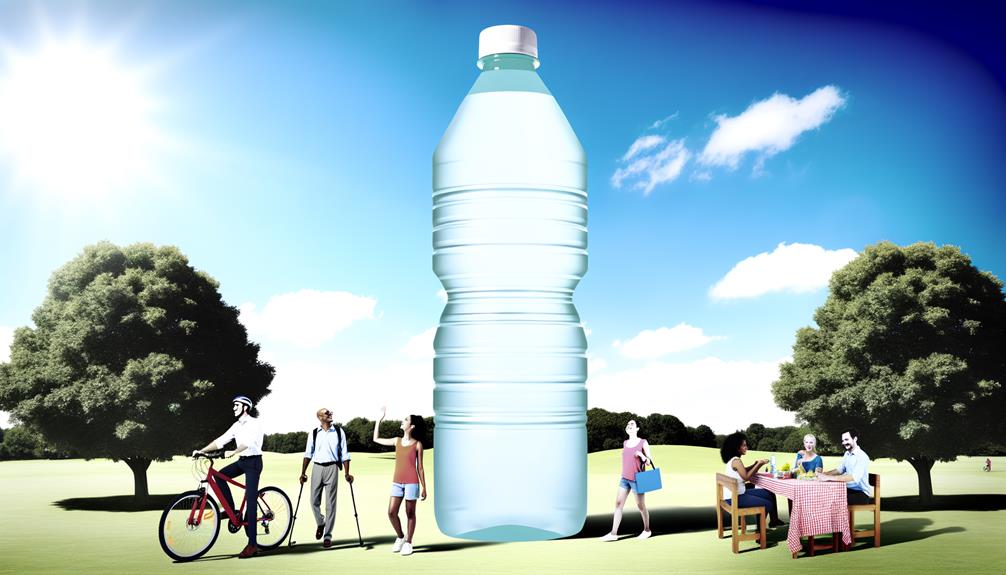
Imagine leveraging the world's largest water bottle for large-scale disaster relief, where its immense capacity can provide essential hydration to thousands in need. This colossal container can be a game-changer in various practical scenarios:
Emergency Water Supply: During natural disasters like earthquakes or hurricanes, rapid deployment of clean water is vital.
Military Operations: Troops in remote locations often face water scarcity; this bottle could support sustained operations.
Humanitarian Missions: In regions suffering from drought, a large water source can greatly impact survival.
Large-Scale Events: Festivals, marathons, or concerts with massive attendance can benefit from this immense water supply.
Comparisons to Other Bottles
While its practical applications are impressive, comparing the world's largest water bottle to traditional water containers highlights the magnitude of its capacity and engineering prowess.
Standard personal water bottles typically hold between 500 milliliters to 1 liter. Even industrial water tanks, which serve communities or large events, usually range from 500 to 10,000 liters.
The world's largest water bottle, however, can contain a staggering 100,000 liters. This capacity dwarfs conventional containers and showcases advanced material engineering and structural integrity.
You'd notice reinforced polymer layers and precision-engineered joints designed to withstand immense pressure and weight. Understanding this comparison helps you appreciate the technological advancements and logistical planning that make such a colossal water bottle feasible and functional.
Future of Giant Bottles
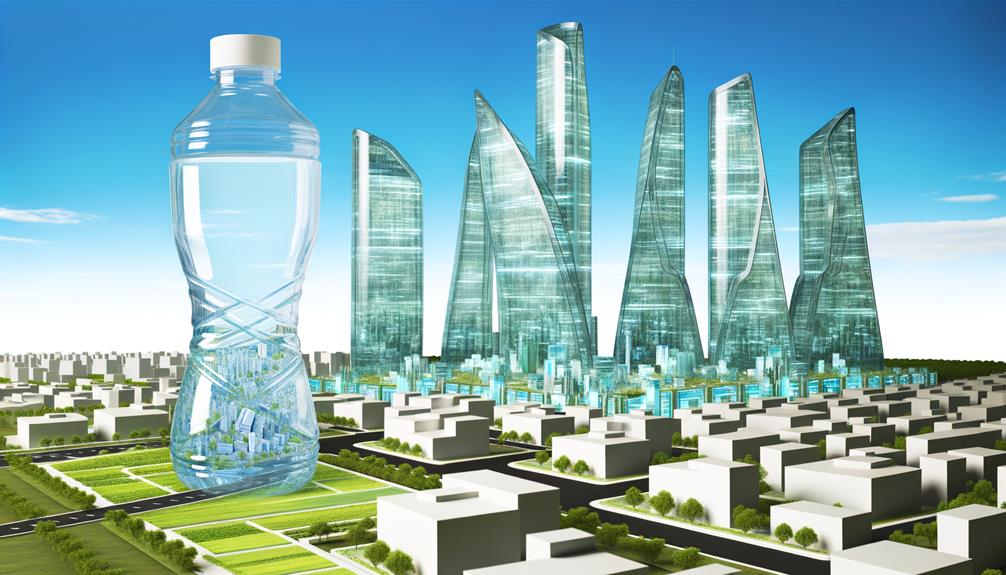
Looking ahead, advancements in materials science and fluid dynamics promise to revolutionize the capabilities and applications of giant water bottles.
Imagine harnessing these innovations to craft bottles that are lighter, stronger, and more efficient. These technologies can lead to:
- Enhanced Durability: Utilization of advanced polymers and composites to withstand higher pressures and environmental stresses.
- Improved Fluid Dynamics: Optimized design to guarantee smoother flow rates and reduced turbulence.
- Sustainability: Incorporation of eco-friendly materials to minimize environmental impact.
Conclusion
In the grand tapestry of engineering marvels, the world's biggest water bottle stands as a symbol of human ingenuity and ambition.
You've journeyed through its historical roots and technical triumphs, witnessing how every drop in the ocean counts.
As you ponder its immense scale and potential, remember: innovation knows no bounds.
This colossal creation not only quenches curiosity but also pushes the envelope of what's possible in design and utility, promising an exciting future for giant bottles.






